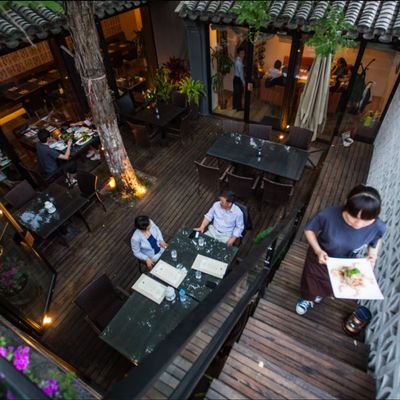
Over the past year, the Beijing city government has implemented a “cleanup” campaign that saw many small venues in the capital’s older, more rustic neighborhoods shuttered. Although many have sadly been consigned to culinary history, some of the best eateries in these areas have survived the cull, offering a taste of local atmosphere as well as great dishes. We asked a few food scenesters, as well as locals who live in the hutongs, about their favorites.
For a Sichuan-style hot spot, go to…
Zhang Mama
“Beijingers love a restaurant where you have to wait outside because it means it’s really good; you’ll often see 30 people waiting at the two Zhang Mama venues. They serve food from the Sichuan province, categorized as being really spicy, using Sichuan peppercorns and chiles. The restaurant is family-run; Zhang Mama is often in the kitchen, with her daughters working front of house. They have a dish called chuan’r chuan’r xiang: You pick vegetable skewers from the refrigerator and they give you a bucket of really fragrant chile ma oil to dip it in. You’ll see a table of four local kids easily eating 60 per table, along with other dishes. Their ma la shang gou is really good, too. It’s made with douban paste and lots of spices and oil, and comes in a massive bowl that easily feeds four to six people. They have a pork rib one and a shrimp one and they come with things like potatoes, asparagus roots, and mushrooms. Another great dish there is the huai gou rou: twice-cooked pork. They take pork-belly slices, boil them, and then pan fry them with seasoning. Then they put fried wonton chips — made from flat dough they throw on the fire — underneath. It’s great value: The last time I went there with friends, we ate like pigs and it was about 60 yuan each ($9.50), with beer.” —Elizabeth Phung, food photographer
For fiery Chongqing noodles, go to…
Pangmei Mianzhuang
“Beijing isn’t the greatest city for noodles, but you wouldn’t know that from eating here. Pangmei Mianzhuang offers supercheap noodle dishes in the style of Chongqing: a direct-controlled municipality once part of Sichuan province, with cuisine now known to be hotter and spicier than Sichuan’s. The house favorite is wan zha mian: a thin wheat noodle that can come dry or in soup, with creamy split yellow peas, traces of spiced minced pork, and generous splashes of chili oil. Get there early, since they’re strict on closing times.” —Lillian Chou, food stylist and former food editor of Time Out Beijing
For a taste of Japan, go to…
Zhuan
“This is our first choice when we want to eat somewhere close to our music venue, even though it’s not always easy to get seats — it’s an izakaya [Japanese-style bar] and it’s really small. It’s worth the wait because the food is great, with authentic Japanese taste. I recommend the yukhoe, which is similar to steak tartare, but reserve my opinion on their ramen. Thankfully this place wasn’t affected by the big ‘brick-up’ campaign that closed many Beijing venues, so let’s just have fun eating for now. Who knows what will happen tomorrow.” —Liu Fei, co-owner of rock music venue School Live Bar
For lamb-heavy Xinjiang cuisine, go to…
Crescent Moon
“When people think of Xinjiang province food, they think of lamb skewers, which Crescent Moon does really well. But what’s great about this place is that they also have lamb mixed with bread, lamb dumplings, and lamb mixed with noodles and fried rice. I always order the da pan ji — it’s a dish that originated in Xinjiang but was created by Sichuan laborers featuring a base of tomatoes, with Sichuan peppercorns and chicken cooked with potatoes. A full portion easily feeds six people. The staff are friendly and the servers are Uyghurs: a Turkic ethnic group that’s largely Islamic, is mainly based in Xinjiang, and has a distinctly different dressing style and language from the Han Chinese, which make up over 90 percent of the country’s population. That combined with the restaurant’s décor makes you feel like you’ve been transported to Xinjiang.” —Elizabeth Phung

For Vietnamese fare served in a courtyard, go to…
Susu
“This is a dreamy courtyard restaurant tucked in an old hutong south of the National Art Museum of China. With stunning interior design, the restaurant is down-to-earth yet refined and has some of the best views in Beijing, thanks to its rooftop terrace. Owners Jonathan Ansfield and Amy Li work with talented young Vietnamese chefs who are masters of mixing rustic and modern. The result is zesty spring rolls and salads, comforting clay pots, simmering pho, and tasty seasonal creations. Some of their best dishes include the signature Susu salad; the No. 10 chicken leg pan-fried with lemongrass, lemon juice and spices; and the sizzling La Vong fish set with snakehead fish fillets sautéed in fennel, turmeric, and scallions. You can’t go wrong with their fresh spring rolls, and I can’t get enough of their banana- and prawn-fried spring roll. Oh, and I would be remiss not to mention their superb cocktails, made with homemade bitters and syrups. The restaurant can be hard to find, so check their online map.” —Kristen Lum, food blogger
For local-style halal barbecue, go to…
Lan Yue Zhai
“It’s a halal Beijing zhi zi barbecue place with delicious lamb and beef. A zhi zi is a round metal plate with long holes on it, that’s placed on a big pot filled with burning coal. Then you put raw meat, vegetables, fish, or whatever else you want on the plate. I always bring incoming bands who visit School Live Bar here for a local bite, because of both the vibe and the food. It’s really casual and street-style; you never have to worry about table manners or being loud here. It’s sort of self-service barbecue, so everyone can have the food they like. Try the kidney.” —Liu Fei